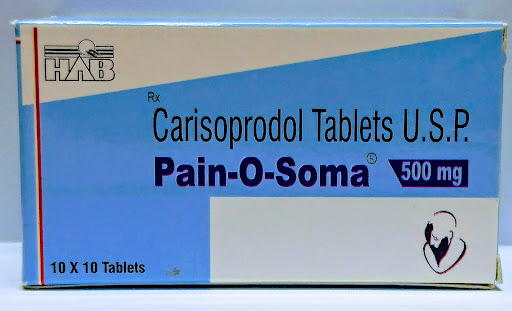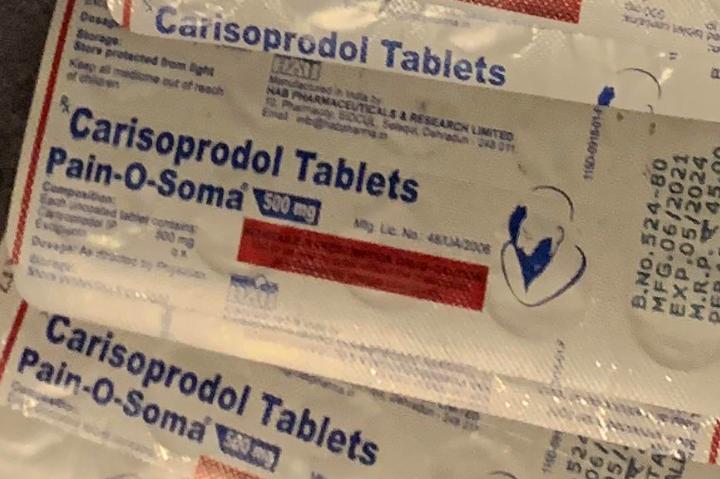Pain O Soma 500mg: Uses Side Effects, Addiction, Reviews

Pain O Soma is a brand of carisoprodol, a muscle relaxant used with rest, physical therapy, and other measures to relax muscles and relieve pain and discomfort caused by strains, sprains, and other muscle injuries.
Pain O Soma works by blocking pain sensations between the nerves and the brain. It should only be used for short periods (up to two or three weeks) because there is no evidence of its effectiveness in long term use and most skeletal muscle injuries are generally of short duration. Carisoprodol is considered a controlled substance in the United States.
What special precautions should I follow?
Before taking Pain O Soma,
• tell your doctor and pharmacist if you are allergic to carisoprodol, meprobamate (Equanil, Meprospan, Miltown, Neuramate), any other medications, or any of the ingredients in carisoprodol tablets. Ask your pharmacist for a list of the ingredients.
• tell your doctor and pharmacist what prescription and nonprescription medications you are taking, especially medications for allergies, coughs, or colds; muscle relaxants; sedatives; sleeping pills; tranquilizers; and vitamins.
• tell your doctor if you have or have ever had kidney or liver disease.
• tell your doctor if you are pregnant, plan to become pregnant, or are breastfeeding. If you become pregnant while taking Pain O Soma, call your doctor.
• talk to your doctor about the risks and benefits of taking Pain O Soma if you are 65 years of age or older. Older adults should not usually take carisoprodol because it is not as safe or effective as other medications that can be used to treat the same condition.
• you should know that this drug may make you drowsy. Do not drive a car or operate machinery until you know how Pain O Soma affects you.
• remember that alcohol can add to the drowsiness caused by this drug.

How should I take Pain O Soma?
Take Pain O Soma exactly as it was prescribed for you. Follow all directions on your prescription label and read all medication guides or instruction sheets.
Pain O Soma may be habit-forming. Misuse can cause addiction, overdose, or death. Selling or giving away this medicine is against the law. Carisoprodol is usually taken 3 times per day and at bedtime and should only be taken for 2 or 3 weeks. Call your doctor if your symptoms do not improve, or if they get worse. Follow your doctor’s dosing instructions very carefully.
Do not stop using this medicine suddenly after long-term use, or you could have unpleasant withdrawal symptoms. Ask your doctor how to safely stop using this medicine.
Pain O Soma is only part of a complete program of treatment that may also include rest, physical therapy, or other pain relief measures. Follow your doctor’s instructions.
Keep track of your medicine. Carisoprodol is a drug of abuse and you should be aware if anyone is using it improperly or without a prescription.
What are the side effects of Pain O Soma?
Pain O Soma may cause side effects. Tell your doctor if any of these symptoms are severe or do not go away:
• drowsiness
• dizziness
• clumsiness
• headache
• fast heart rate
• upset stomach
• vomiting
• skin rash
If you experience any of the following symptoms, call your doctor immediately:
• difficulty breathing
• fever
• weakness
• burning in the eyes
If you experience a serious side effect, you or your doctor may send a report to the Food and Drug Administration’s (FDA) MedWatch Adverse Event Reporting program online (http://www.fda.gov/Safety/MedWatch) or by phone (1-800-332-1088).
Pain O Soma Safety Information
You should not take Pain O Soma if you have porphyria (a genetic enzyme disorder that causes symptoms affecting the skin or nervous system).
Pain O Soma may be habit-forming. Never share this medicine with another person. Misuse of habit-forming medicine can cause addiction, overdose, or death.
Pain O Soma can cause side effects that may impair your thinking or reactions. Be careful if you drive or do anything that requires you to be awake and alert. Avoid drinking alcohol. It can increase drowsiness and dizziness caused by this medicine.
You may have withdrawal symptoms when you stop using this medicine after using it over a long period of time. Do not stop using this medication suddenly without first talking to your doctor. You may need to use less and less before you stop the medication completely.





